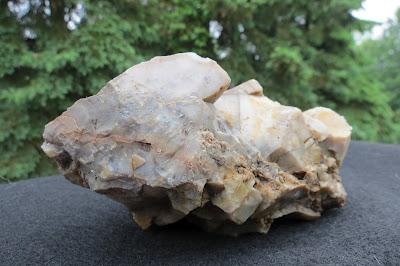Buckeye Lake sculpture hoard #6 of 7 has been interpreted as an example of a Janus-like figure depicting a jawless skull and a bearded man facing away from each other, one in left profile and the other in right profile view, seen respectively above. This form was originally described by
Jacques Boucher de Perthes in France and has been further described most recently by
art scholar and author Pietro Gaietto of Italy.
side 2 of hoard sculpture #6 of 7
A gouged and drilled hole demonstrating the artificiality of this flint object
An image of a bearded (goateed) man in right profile view was found on the sculpture only after I read Gaietto's interpretation of this sculpture form as having two human heads. When I looked, this face was seen as predicted by Gaietto's work. The rough oolithic surface of the flint was ground until it was smooth to create the skin component of the face in the image. Gouges have been made in place for an ear and an eye, and there is an incised line in the place of the mouth. Please see illustrations below for markups of these features.
A fair visual comparison of Ohio votive hoard sculpture #6 here to Gaietto’s #5.24 example of the same letter “n" shaped type, demonstrates even further compelling evidence of a European cultural influence on the maker(s) of the Ohio sculptures. According to Gaietto, it represents a skull without jawbone with a second human depicted on the rear of the skull, facing away, Janus-like.
I thought Buckeye Lake hoard #6 of 7 had some quasi-zoomorphic features and a gouged and then drilled hole on side 2 of the piece which demonstrated its artifactuality. When I came across this piece identified as an intended sculpture by Gaietto, I recognized the strong similarity to the Ohio sculpture. They both share a snout-like aspect on the left in these views, an arched gap in the base line and a squared off aspect on the right end.
The Ohio #6 sculpture cannot exist wholly independent, however far in time and distance, of influence from the peoples who made sculpture #5.24 found at Campo, Liguria, in northern Italy. The morphology is too complex, so tied to deep culture, spirituality-- and so very similar, that Ohio #6 cannot be an artifact of independent invention or coincidence.
Illustrations Copyright (c) Pietro Gaietto, All Rights Reserved.
(click photos to expand and compare)
Gaietto's descriptions of letter “n" shaped or "two-headed" sculptures,
first identified by Jacques Boucher de Perthes in 1860, helped identify a bearded man right facial profile image on #7, which was not detected prior but found in place by Johnston as predicted by Gaietto. The successful interpretation of the Ohio sculpture using previously described methods helps confirm its status as a European influenced American art sculpture. Likewise, Gaietto's descriptions of proto-art, pre-sculpture and early sculpture of hominins, which is not accepted by mainstream archaeology, is validated by being applicable (replicable) and informative to this case and must be so credited and duly recognized.
Original illustrations by Boucher de Perthes (1847) of the letter 'n' shaped sculpture form.
Number 18 illustration of Boucher de Perthes demonstrating similarity to the Buckeye Lake sculpture hoard #6 of 7
"Common sense tells us that the primitive people who made haches and tools were able to make figures... ...As to the Symbols and Figures, although I have gathered of these some types which may be seen at my house to-day, numbering about fifty analogous shapes on which the human work is evident, I have converted very few people, and of the number, not one Englishman. Why-they say to me-are you the only one who finds Figure Stones ? Have they never been found anywhere else than at Abbeville ?-and-mention one collection besides your own in which they have been seen ...To-day, Sir, your examples will be questioned, I do not say that I shall have gained my cause, but Truth will have made one more step, and will strike forcibly by coming from two sides."
- From a lettter from Jacques Boucher de Perthes to Victor Chatel, Oct 20th, 1866
The "two sides" Boucher de Perthes was referring to are of the English Channel, France and England. I propose the "two sides" may now be expanded to be taken as "two sides of the Atlantic Ocean" to include Europe and North America.
-kbj





.jpg)












.jpg)




































